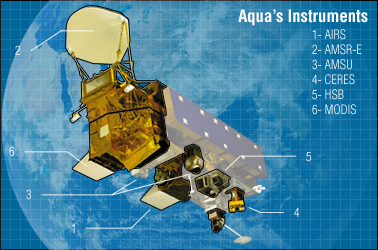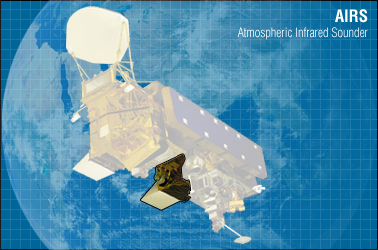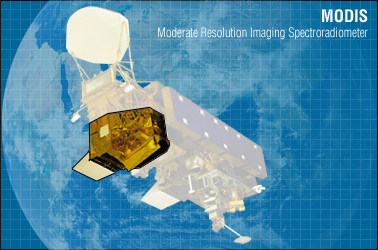Aqua - Project Science

Aqua is a NASA Earth Science satellite mission named for the large amount of information that the mission will be collecting about the Earth's water cycle, including evaporation from the oceans, water vapor in the atmosphere, clouds, precipitation, soil moisture, sea ice, land ice, and snow cover on the land and ice. Additional variables also being measured by Aqua include radiative energy fluxes, aerosols, vegetation cover on the land, phytoplankton and dissolved organic matter in the oceans, and air, land, and water temperatures.
Instruments
I) AIRS: Atmospheric InfraRed Sounder

What is AIRS and what does the AIRS instrument suite measure?
The Atmospheric Infrared Sounder (AIRS) is a facility instrument onboard the polar-orbiting Earth Observing System (EOS) Aqua satellite which was successfully launched on May 4, 2002. In combination with the Advanced Microwave Sounding Unit (AMSU-A) and the Humidity Sounder for Brazil (HSB), the AIRS instrument suite constitutes an innovative atmospheric sounding group of visible, infrared, and microwave sensors.

AIRS is a high spectral resolution spectrometer with 2378 bands in the thermal infrared (3.7 - 15.4 µm) and 4 bands in the visible (0.4 - 1.0 µm). These ranges have been specifically selected to allow determination of atmospheric temperature with an accuracy of 1°C in layers 1 km thick, and humidity with an accuracy of 20% in layers 2 km thick in the troposphere.
AIRS will make measurements of the Earth's atmosphere and surface that will allow scientists to improve weather prediction and to observe changes in Earth's climate.
For more information see the AIRS instrument guide: http://disc.sci.gsfc.nasa.gov/AIRS/additional/documentation/airs_instrument_guide.shtml
II) MODIS: Moderate Resolution Imaging Spectroradiometer

MODIS is a 36-band spectroradiometer measuring visible and infrared radiation and obtaining data that are being used to derive products ranging from vegetation, land surface cover, and ocean chlorophyll fluorescence to cloud and aerosol properties, fire occurrence, snow cover on the land, and sea ice cover on the oceans.
The instrument characteristics are for example 36 spectral bands (21 within 0.4-3.0 µm and 15 within 3-14.5 µm), continuous global coverage every 1 to 2 days, signal-to-noise ratios from 900 to 1300 for 1 km ocean color bands at 70° solar zenith angle and daylight reflection, day/night emission spectral imaging and resolutions of 250 m (2 bands) / 500 m (5 bands) / 1000 m (29 bands).
Quellen:
http://disc.sci.gsfc.nasa.gov/AIRS/additional/instruments.shtml#1.
